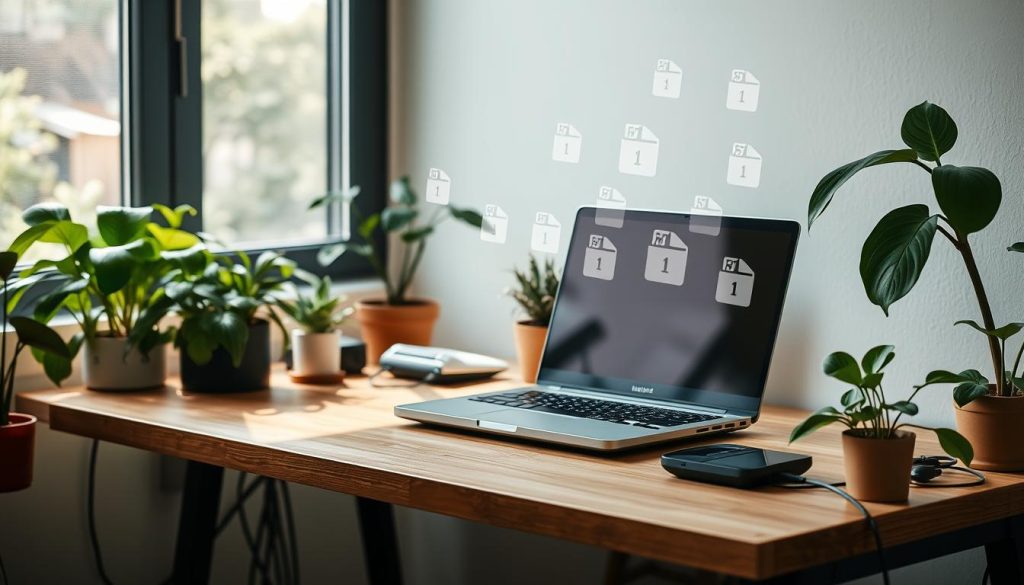Technology is moving fast, and so is the problem of e-waste. We’re surrounded by old gadgets, harming our planet. It’s time to focus on eco-friendly electronics disposal.
Living sustainably with technology is essential. I’m on a mission to find ways to cut down on e-waste. We must act now to protect our environment.
Understanding E-Waste and Its Impact
In today’s fast world, e-waste is a big problem. Old phones and computers are just the start. Knowing about e-waste and its effects is key to a greener future.
What is E-Waste?
E-waste, or electronic waste, includes old gadgets like phones, computers, and TVs. As new tech comes out, these items get thrown away. This creates a huge problem.
The Environmental Consequences of E-Waste
E-waste harms our planet in many ways. Bad disposal can pollute soil and hurt animals. Toxic chemicals like mercury can get into our environment, risking health.
The Importance of Reducing E-Waste
We all need to work on cutting down e-waste. Doing so helps the planet and saves resources. Recycling gadgets means we use less new stuff. This keeps our world healthy for the next generation.
| Key Factor | Impact |
|---|---|
| Soil Contamination | Heavy metals from e-waste can leach into the soil, disrupting ecosystems. |
| Wildlife Harm | Toxic substances can enter food chains, damaging animal health. |
| Resource Conservation | Recycling reduces the need for raw material extraction. |
My Journey Toward Reducing E-Waste

Starting my personal e-waste reduction journey opened my eyes. I didn’t know how much waste I was creating until I looked at my habits. I saw all the old devices in my drawers.
Discovering My E-Waste Footprint
During a spring cleaning, I found old phones, chargers, and laptops. It was shocking to see how much I had replaced but not thrown away. This made me realize I had to stop contributing to the problem.
The Moments That Sparked Change
Several moments made me want to reduce digital waste. A documentary on e-waste’s harm made me see the global issue. Reading about others who changed their ways also inspired me.
My First Steps Toward Eco-Friendly Tech
Starting to reduce e-waste was tough but rewarding. I began by fixing devices instead of buying new ones. I also chose second-hand electronics and kept my gadgets updated. These steps were the start of my journey to a greener tech life.
Effective Strategies for Reducing E-Waste

Reducing e-waste is key for our planet. There are many ways to do this. Repairing electronics instead of buying new ones is a big help. Let’s look at some tips and benefits of using sustainable technology.
Repairing vs. Replacing Devices
Repairing gadgets is a powerful way to cut down e-waste. Fixing things like a broken phone screen or a laptop issue can make your devices last longer. This not only lowers e-waste but also helps the environment by reducing the need for new products.
Choosing Quality Over Quantity
When buying new electronics, pick quality over quantity. Choosing durable, high-quality items from trusted brands means they’ll last longer. This reduces the need for frequent replacements. Also, picking brands that focus on eco-friendly upgrades helps our planet.
Upgrading Components Instead of Devices
Upgrading parts of a device can be smarter than getting a new one. For example, adding a new hard drive or RAM to a computer can improve its performance. This method is good for the environment and reduces e-waste by avoiding full device disposal.
The Role of Responsible Recycling
Responsible e-waste disposal is key to our electronic sustainability efforts. Picking a trustworthy e-waste recycler means devices are recycled right. It helps save resources and lessens harm to our environment.
Finding a Trusted E-Waste Recycler
Look for e-waste recyclers with certifications like R2 and e-Stewards. These show they follow strict recycling standards. Check reviews and ask about their environmental promises.
Benefits of Recycling E-Waste Properly
Recycling e-waste has many pluses. It saves valuable materials and cuts down on pollution. It also keeps our planet clean for the next generations.
How to Prepare Your Devices for Recycling
Before recycling, wipe your devices clean of personal data. A factory reset is a smart move. Also, remove batteries since they’re hazardous and need special recycling.
Embracing Minimalism in Technology

Embracing technology minimalism helps us simplify our lives. It means we carefully choose what tech we need. This approach brings many benefits to our digital and physical spaces.
Evaluating My Tech Essentials
I looked closely at my gadgets to start. The first step is figuring out what I really need versus what I just want. I cut down to one laptop and one smartphone, getting rid of extra devices.
Digital Decluttering: Apps and Tools
Next, I tackled digital clutter. I used apps and tools to clean up my digital space:
- CleanMyMac: It’s key for removing junk files and unwanted apps from my MacBook.
- Google Files: It helped me get rid of old downloads and useless files on my Android.
- Trello: It made my task management simpler, cutting down on sticky notes and random audio notes.
The Benefits of a Tech Minimalist Lifestyle
Living a minimalist tech life has many benefits. With fewer gadgets and regular digital cleaning, I’m more productive and less stressed. It also helps the environment by reducing e-waste and supporting green practices.
Supporting Sustainable Brands
In today’s world, it’s crucial to support sustainable tech brands. Our choices have a big impact on the environment. By picking companies that care about the planet, we help cut down on e-waste and push for change.
Researching Eco-Friendly Tech Companies
First, we need to research eco-friendly companies. Look into their efforts to reduce e-waste and their environmental impact. Start by checking their websites for sustainability reports and look for environmental certifications.
Why Brand Responsibility Matters
Brand responsibility in e-waste reduction is key for a greener future. When companies manage their e-waste, they protect the environment and set a good example. Transparency, green manufacturing, and recycling show a brand’s dedication to the planet.
My Favorite Sustainable Tech Brands
I’ve found some top sustainable tech brands. For instance:
- Apple: It’s known for recycling programs and lowering carbon footprints in its products.
- Fairphone: It focuses on ethical materials, easy-to-fix phones, and recycling.
- HP: It uses sustainable materials and offers recycling for old devices.
Supporting these brands helps promote green practices in tech. Let’s choose products from companies that care about the environment and are accountable.
Educating Others About E-Waste
Talking about e-waste with others can be very rewarding. It helps spread the word and gets people to take action. I love sharing what I’ve learned about e-waste education.
Sharing Knowledge with Family and Friends
Starting small, I talk to my family and friends about e-waste. Simple chats can spark interest and encourage them to use tech more sustainably. I tell them about recycling and proper disposal of old devices.
Hosting E-Waste Awareness Events
Hosting events in my community is a big step. I organize everything from library talks to workshops on fixing old gadgets. Working with local groups and businesses makes these events more fun and informative.
Utilizing Social Media for Advocacy
Social media is a great tool for spreading the word. Sites like Facebook and Twitter let me share tips and news about e-waste. It’s a way to reach more people and make a bigger impact.
| Method | Benefits |
|---|---|
| Sharing Knowledge with Family and Friends | Direct impact, personal approach |
| Hosting E-Waste Awareness Events | Engages community, hands-on learning |
| Utilizing Social Media for Advocacy | Broad reach, real-time engagement |
Resources for Reducing E-Waste
My journey toward a sustainable lifestyle led me to many resources for reducing e-waste. These tools have helped me track my e-waste, learn about management, and find organizations fighting for the environment. Here are some key tools, literature, and groups that have made a big difference.
Online Tools to Track E-Waste
Understanding e-waste is key, and online tools make it easy. The EPA’s Electronics Environmental Benefits Calculator and Decluttr’s trade-in program are great. They help me monitor my e-waste and make better choices about recycling and using devices.
Books and Articles on E-Waste Management
Books like “Junkyard Planet” by Adam Minter and “High Tech Trash” by Elizabeth Grossman have opened my eyes. Articles from Environmental Leader and GreenBiz keep me updated on new trends. Reading these helps me make greener choices.
Organizations Promoting Sustainable Practices
Many groups are fighting e-waste and promoting sustainability. The Natural Resources Defense Council (NRDC) and Basel Action Network (BAN) are my favorites. They offer advice, advocate for responsible e-waste, and support global projects. Working with these groups has given me practical tips and connected me with others who care about our planet.

